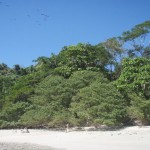Cabo Blanco National Park Costa Rica
Cabo Blaco National Park is located in the province of Puntarenas, on the southern tip of the Nicoya Peninsula. It was created by Executive Decree No. 10 of October 21, 1963. Its area is 1,172 hectares and 1,790 hectares land in the marina.
Cabo Blanco is a haven for flora and fauna of the Pacific dry for many marine species. It is of great importance for their scenic beauty.
Cabo Blanco is located within the area of life in the rainforest. Here is dominated by evergreen species mixed with deciduous species. Some of the most common species are the jobo, Indian nude, madrone, guácimo, guarumo chaperno and pochote, commercially valuable species.
In the areas of primary forest stand pochote medlar, and espavel. In this wilderness area have reported 119 species of trees.
The fauna of the reserve is not very diverse. However, there are species of mammals such as deer, howler monkeys, red and white face, the porcupine, agouti, the tepescuinte, hammers, coyote, armadillo and armadillo or ocelot or margay.
Seabirds are very numerous, particularly brown pelicans, frigate birds, gulls of black-heads, terns and brown boobies.
Meanwhile, land birds are the most characteristic toledo, the magpie, the cattle egret, vulture, the red widow, the green heron, the chachalaca, collajero kingfisher, parakeet cabercirrojo aliamarillo and the buzzard.
In marine environments is possible to see many fish, crabs, chitons, snails, lobster, queen conch, shrimp, clams and many other species.
There are four programs of reserve management. The research program aims to develop research, and identify and implement measures for their control and supervision.
The maintenance program that was established for the improvement and construction of facilities within the reserve.
The Agenda for Protection prevents illegal actions within the reserve such as hunting, fishing, fires and any extraction of forest products.
The Environmental Education Program supports community relations to create a favorable atmosphere among the people surrounding the reserve. It also ensures the attention of domestic and foreign tourists who visit the reserve.

